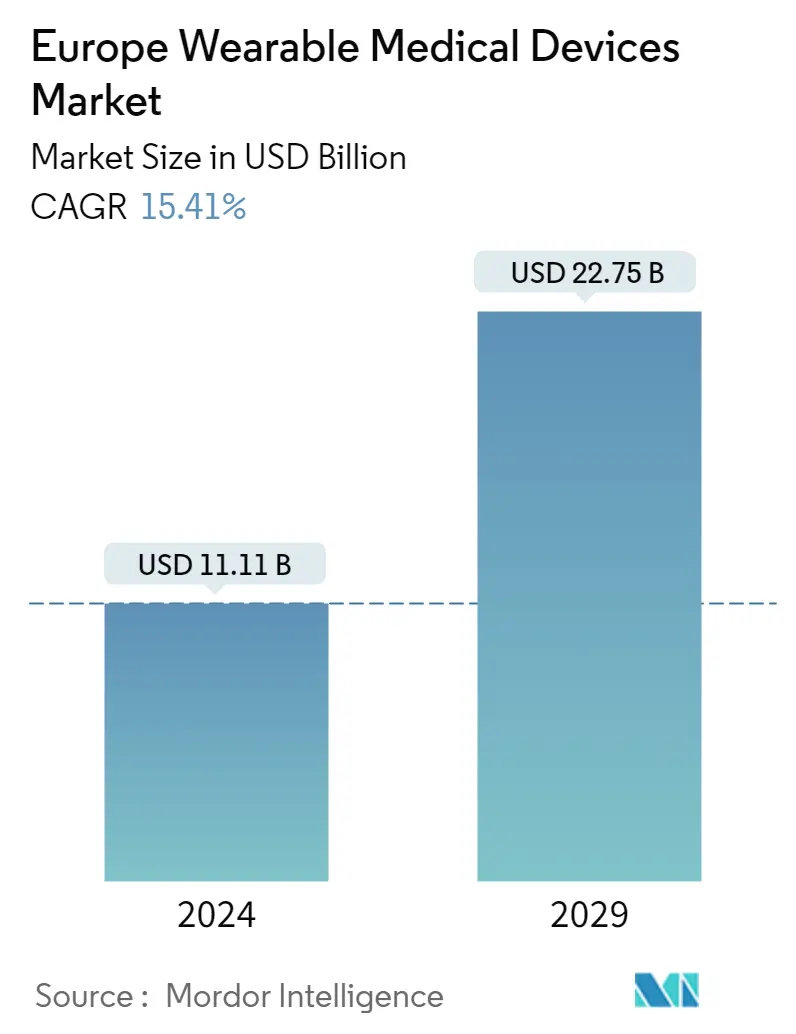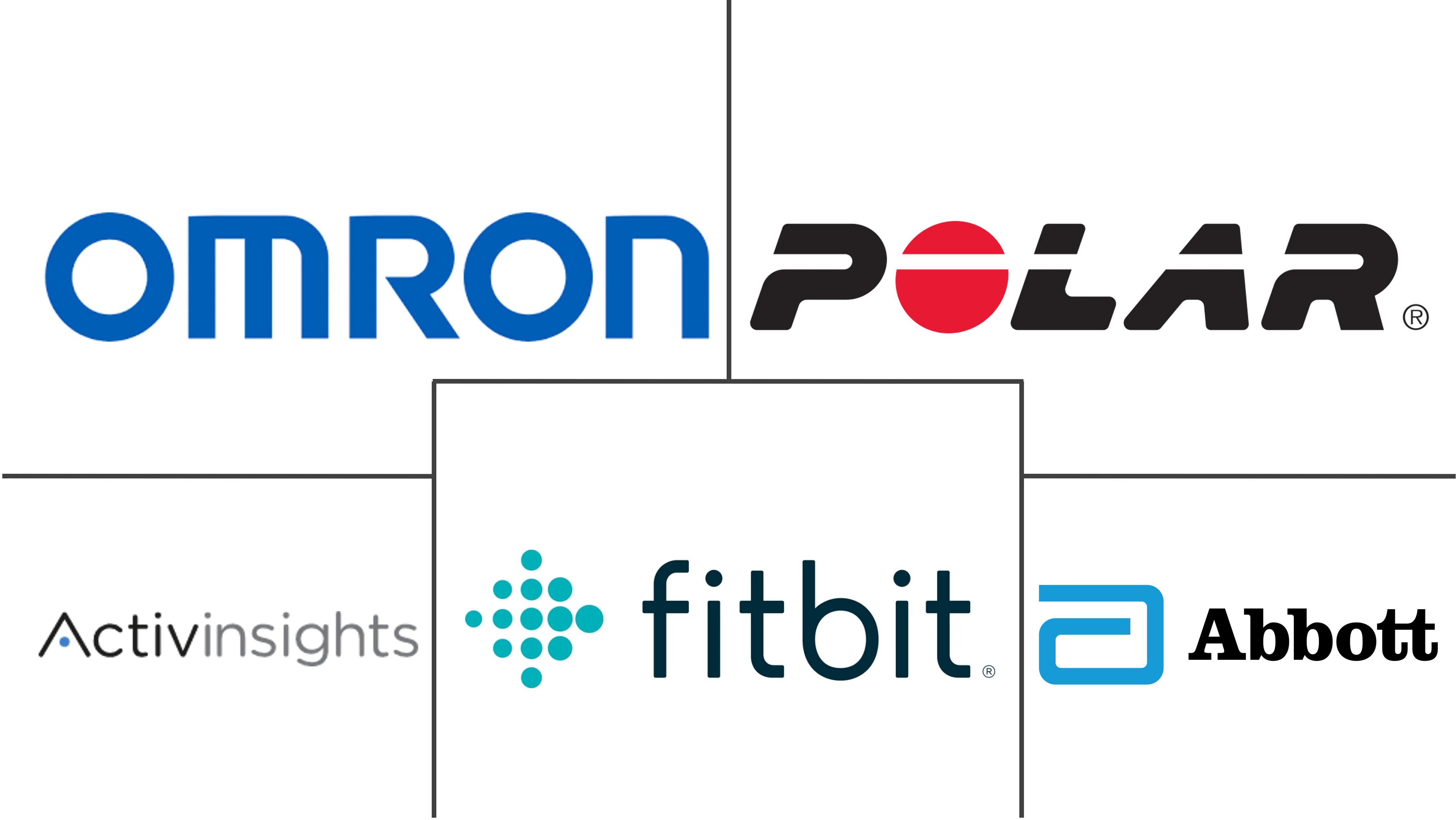Market Size of Europe Wearable Medical Devices Industry

| Study Period | 2019 - 2029 |
| Base Year For Estimation | 2023 |
| Forecast Data Period | 2024 - 2029 |
| Market Size (2024) | USD 11.11 Billion |
| Market Size (2029) | USD 22.75 Billion |
| CAGR (2024 - 2029) | 15.41 % |
Major Players
*Disclaimer: Major Players sorted in no particular order |
Need a report that reflects how COVID-19 has impacted this market and its growth?
Europe Wearable Medical Devices Market Analysis
The Europe Wearable Medical Devices Market size is estimated at USD 11.11 billion in 2024, and is expected to reach USD 22.75 billion by 2029, growing at a CAGR of 15.41% during the forecast period (2024-2029).
The COVID-19 pandemic has significantly impacted market growth. The demand for wearable devices and patient monitoring devices has increased during the pandemic period as they allow contactless communication and tracking of medical conditions by clinicians. The spread and early diagnosis of COVID-19 can be determined through the remote monitoring of vital signs such as skin and body temperature, respiratory rate, pulse rate, heart rate, and blood oxygen level, which are related to COVID-19. This is anticipated to have a positive effect on the growth of the studied market. For instance, according to an article published by The Lancet Digital Health Journal, in April 2022, titled "Effectiveness and safety of pulse oximetry in remote patient monitoring of patients with COVID-19: a systematic review", it has been found that pulse oximetry is a practical method for determining whether patients need hospital treatment or may be safely handled at home by remotely monitoring their SpO2 levels.
In addition, as per the same source, in the United Kingdom, COVID Oximetry @home15 is a national program of care for patients with COVID-19 in England. The program aims to monitor SpO2 remotely in patients who are at the risk of worsening from silent hypoxia. Also, the model seeks to improve patient care and ensure more efficient use of National Health Service resources. Hence, the increased usage of remote patient monitoring devices and other wearable devices to monitor health conditions during pandemics has positively impacted the market growth. Similarly, according to a study published in Nature Electronics, in January 2021, titled "Wearable devices for the detection of COVID-19," the early diagnosis of asymptomatic and presymptomatic COVID-19 cases can be accomplished by using wearable electronic devices that continuously monitor physiological data. Thus, the increasing use of wearable devices in diagnosing and detecting the COVID-19 symptoms and monitoring the health condition of various patients suffering from chronic diseases is expected to increase the adoption of these devices among the population, which in turn is expected to increase the market growth during the COVID-19 pandemic.
Certain factors that are driving the market growth are rising technological advancements and product innovation, increasing health awareness among the population, and advantages offered by the wearable devices such as ease of use and data interpretation.
Other factors, such as continuous product development and commercialization, and strengthening distribution channels of major product manufacturers are expected to aid the growth of the Europe wearable medical devices market. For instance, in December 2021, Xiaomi launched Redmi Watch 2 Lite smartwatch in the European market, Germany for EUR 79. It supports several features, including tracking blood oxygen levels, steps taken, and heart rate. Also, in April 2020, Withings launched the latest sleep-tracking device, Sleep Analyzer, a mat that can be used to detect sleep apnea. The device analyzes sleep and snoring episodes by using its advanced sensors when placed underneath a mattress.
Furthermore, the increasing initiatives to rise health awareness regarding various chronic diseases among the population in the region are also contributing to the growth of the studied market over the forecast period. For instance, in December 2021, the European Commission launched the Healthier Together - EU non-communicable diseases (NCD) initiative to support European countries in identifying and implementing effective policies and actions to reduce the burden of major NCDs and improve citizens' health and well-being. The initiative includes five strands such as health determinants, cardiovascular diseases, diabetes, chronic respiratory diseases, mental health, and neurological disorders.
However, the lack of reimbursement policies in Europe is likely to restrain the market growth over the forecast period.
